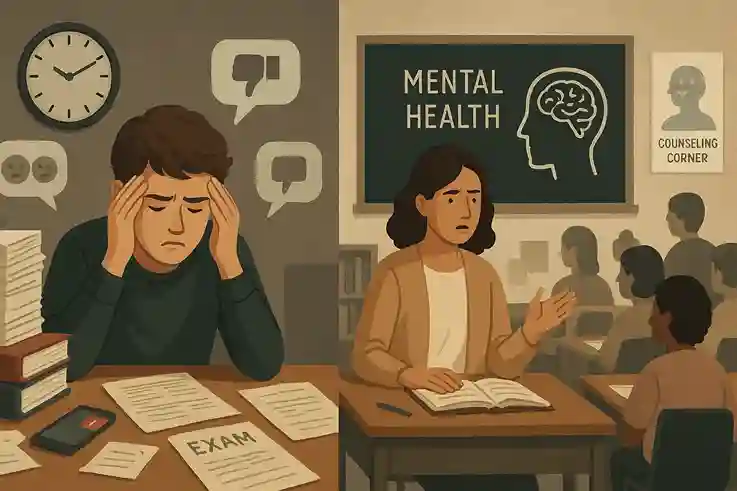Mental Health in Education: Effective Ways to Support
Mental health in education has emerged as one of the most pressing priorities in the U.S. school system. It is no longer a secondary concern but a defining factor in student achievement, teacher performance, and overall school climate. Across elementary, middle, and high schools, educators are witnessing the effects of anxiety, depression, and emotional stress on both academic outcomes and personal development.
Rising awareness, supported by research and advocacy, has helped place mental health firmly on the national agenda. Yet, the gap between recognition and action remains significant. While some schools have adopted innovative programs, many continue to lack the resources, trained staff, and structured policies needed to address these challenges effectively.
The stakes are high. Without proper support, students can struggle to focus, develop unhealthy coping mechanisms, and disengage from learning altogether. Teachers, too, face growing emotional strain, with burnout rates climbing and retention becoming an increasing concern.
This article provides practical, evidence-based strategies designed to strengthen mental health support within U.S. educational settings. It will explore proven approaches to creating safe environments, building emotional resilience, and reducing stigma. Readers will gain a clear understanding of both the challenges and the actionable solutions that can transform classrooms into places where academic success and mental well-being thrive together.
Understanding Mental Health in the U.S. Education System

Definition and Scope
Mental health in education refers to the emotional, psychological, and social well-being of students, teachers, and staff within a school environment. It encompasses the ability to manage stress, build positive relationships, make responsible decisions, and adapt to challenges. In educational settings, mental health directly influences learning outcomes, classroom engagement, and overall school culture.
Current Statistics
Recent national surveys show that approximately one in five students in the U.S. experiences a diagnosable mental health condition each year. Among high school students, over 40% report persistent feelings of sadness or hopelessness, while teacher burnout rates have reached historic highs, with more than 55% of educators considering leaving the profession due to stress and workload pressures. These figures highlight a growing crisis that affects both the teaching and learning experience.
Emily, a high school sophomore, has always been a diligent student. Yet, during exam season, her hands shake, her heart races, and her mind feels blank. Despite her preparation, the anxiety she experiences during tests undermines her performance. Her teachers notice subtle changes—missed homework, quiet withdrawal during group activities—and begin to realize that academic support alone is not enough.
Importance of Early Recognition and Intervention
Early identification of mental health concerns is critical to preventing escalation and long-term consequences. Intervening promptly can help students like Emily regain confidence, learn coping strategies, and re-engage with their studies. For educators, early support reduces burnout risk and strengthens the capacity to foster a positive classroom environment. Proactive measures—such as regular check-ins, accessible counseling services, and teacher training in mental health literacy—can shift schools from a reactive to a preventive model.
Key Challenges Affecting Mental Health in Education

Mental health in education is shaped by a complex set of pressures that affect both students and educators. These challenges often intersect, amplifying their impact on academic achievement and school well-being.
Academic Pressure and Standardized Testing
High-stakes testing remains a dominant feature in the U.S. education system, influencing curriculum priorities and classroom dynamics. While intended to measure achievement and maintain standards, these exams often generate chronic stress as students strive for top scores. This constant pressure can undermine intrinsic motivation, shifting focus from curiosity-driven learning to score-focused performance.
Many students also face performance anxiety during exams, experiencing racing thoughts, physical tension, and difficulty recalling information. Over time, this cycle can erode confidence, limit risk-taking in academics, and reduce overall engagement with learning.
Social Media and Cyberbullying
While social media offers students opportunities for connection, collaboration, and self-expression, it also introduces significant risks. Platforms can expose young people to cyberbullying, comparison culture, and unrealistic self-image standards. The constant stream of curated posts often creates pressure to meet unattainable ideals, leading to feelings of inadequacy.
Cyberbullying, in particular, can inflict lasting emotional harm, contributing to isolation, depression, and diminished self-esteem. These struggles frequently carry over into the classroom, affecting attendance, focus, and willingness to participate, ultimately impacting academic progress and peer relationships.
Teacher Burnout and Staff Shortages
Educators face increasingly heavy workloads, emotional strain, and limited support systems, creating a demanding environment that takes a toll on their well-being. Lesson planning, grading, extracurricular responsibilities, and administrative duties often extend beyond the school day, leaving little time for rest or personal renewal. Teacher shortages exacerbate these challenges by increasing class sizes and limiting the ability to provide individualized attention to students.
Over time, these pressures fuel burnout, characterized by exhaustion, reduced motivation, and a diminished sense of accomplishment. Burnout not only impacts teaching quality and classroom stability but can also accelerate turnover, further straining already under-resourced schools.
Stigma and Lack of Open Discussion
Despite growing awareness, many schools still struggle to normalize conversations about mental health. Students may hesitate to share their concerns out of fear of being judged, labeled, or misunderstood. Educators, while often willing to help, may feel ill-equipped to address sensitive topics due to limited training or resources. This lack of open dialogue can create an environment where emotional struggles remain hidden.
Without early disclosure, opportunities for timely support are lost, allowing issues to escalate and affect both academic performance and personal well-being. Overcoming this barrier requires intentional efforts to reduce stigma, foster trust, and integrate mental health literacy into everyday school culture.
Challenges vs. Potential Impact on Learning Outcomes
| Challenge | Potential Impact on Learning Outcomes |
|---|---|
| Academic pressure & standardized testing | Increased anxiety, lower creativity, reduced engagement |
| Social media & cyberbullying | Poor self-esteem, absenteeism, decreased academic performance |
| Teacher burnout & staff shortages | Lower instructional quality, inconsistent student support, reduced morale |
| Stigma & lack of discussion | Delayed intervention, ongoing distress, lack of coping strategies |
Powerful Ways to Support Mental Health in Education
Strengthening mental health in education requires a comprehensive, proactive approach that addresses the needs of both students and educators. The following strategies combine evidence-based practices with practical applications for U.S. schools.

1. Promote Open Conversations
Schools that encourage open dialogue about mental well-being take an essential step toward reducing stigma and building trust within the educational community. When conversations about emotional health are normalized, students feel safer expressing their concerns without fear of judgment, while educators gain insight into the challenges their students face.
This culture of openness can be fostered through structured classroom discussions where topics such as stress management, resilience, and empathy are addressed alongside academic subjects. Awareness campaigns, including themed weeks, poster drives, and student-led presentations, can highlight the importance of mental health and showcase available resources.
Teacher-led initiatives
Teacher-led initiatives play a central role in sustaining these efforts. Educators trained in mental health literacy can identify early signs of distress, respond with empathy, and connect students to appropriate support. Consistent, nonjudgmental engagement from trusted adults strengthens relationships, encourages help-seeking behavior, and promotes a sense of belonging.
Over time, these practices can transform the school environment into one where mental health is valued as highly as academic achievement, fostering both emotional well-being and stronger learning outcomes.
Mr. Thompson, a middle school teacher, introduced “Wellness Wednesdays,” where students could openly share challenges and coping strategies. Over time, participation grew, and absentee rates dropped.
2. Integrate Mental Health into the Curriculum
Embedding emotional literacy and coping skills into academic subjects is a powerful way to strengthen mental health in education. When topics like self-awareness, empathy, and stress management are woven into core subjects, they normalize conversations about emotional well-being and provide students with tools they can use beyond the classroom.
For example, literature classes can examine characters’ emotional journeys to spark discussions on empathy and perspective-taking. Health education can include practical lessons on identifying stress triggers and applying coping strategies. Even science or social studies courses can explore the psychology of decision-making, the effects of stress on the brain, or the role of resilience in human development.
By embedding these lessons into everyday learning, schools reinforce the idea that mental health in education is as vital as academic achievement. Students gain not only the knowledge to manage emotions in academic settings but also life skills for navigating relationships, setbacks, and major life transitions. This integrated approach produces well-rounded learners capable of thriving both inside and outside the classroom.
3. Strengthen Teacher Support Systems
Teachers play a pivotal role in promoting mental health in education, yet they often face their own emotional and professional challenges. When educators are overworked, under-supported, or emotionally drained, their ability to foster a positive learning environment diminishes. To ensure teachers can effectively support students, schools must also prioritize the well-being of their staff.
Providing professional development in mental health literacy equips teachers with the knowledge to identify early warning signs of distress, respond with empathy, and connect students to appropriate resources. Access to on-site or external counseling services gives educators a safe space to address their own stress, anxiety, or burnout before these issues escalate.
Peer mentorship programs can also be invaluable, pairing experienced educators with newer staff to share strategies, offer emotional support, and reduce professional isolation. By investing in these systems, schools not only improve teacher retention but also strengthen the overall culture of care, ensuring that mental health in education is supported at every level—from the classroom to the staff room.
4. Enhance Access to Counseling Services
Expanding school counseling capacity is essential for strengthening mental health in education. Timely access to qualified professionals can make the difference between early intervention and prolonged struggles for students facing emotional, social, or academic challenges.
This expansion can begin with hiring additional on-site counselors, ensuring student-to-counselor ratios align with national best-practice recommendations. When in-person staffing cannot fully meet demand, teletherapy options can bridge the gap, providing flexible, confidential access to licensed mental health professionals.
Forming partnerships with local mental health providers extends the range of services available, allowing schools to connect students with specialized care such as trauma therapy, behavioral interventions, or family counseling. These collaborations not only improve access but also create continuity of care between school and community services.
By investing in these measures, schools signal that mental health in education is a priority, helping students receive the right support at the right time and improving overall academic and personal outcomes.
5. Foster a Positive School Climate
Creating an inclusive and respectful environment is a cornerstone of promoting mental health in education. When students feel safe, valued, and respected, the risk factors that contribute to anxiety, depression, and social withdrawal are significantly reduced.
Comprehensive anti-bullying programs
Including clear policies, staff training, and student-led awareness initiatives—help address harmful behaviors before they escalate. Encouraging student leadership opportunities, such as peer mentoring, student councils, and club leadership, fosters a sense of belonging and empowerment.
Strong community involvement further enhances this environment. Collaborations with local organizations, parents, and civic leaders can bring fresh resources, diverse perspectives, and additional support systems into the school. These efforts signal to students that they are part of a larger, caring network invested in their well-being.
By embedding these practices into daily school life, educators can help ensure that mental health in education is not only supported but actively nurtured, creating a lasting foundation for academic and personal success.
Role of Parents and Guardians
Recognizing Signs of Distress at Home
Parents and guardians are often the first to recognize early signs of challenges linked to mental health in education. These indicators may present as sudden mood changes, withdrawal from friends or family, noticeable shifts in sleep patterns, or a decline in academic engagement. Subtle changes in behavior, such as irritability or loss of interest in hobbies, can also be early warning signals. Identifying these signs promptly allows families to seek appropriate support, initiate open conversations, and coordinate with schools to prevent issues from escalating.
Collaborating with Schools for Consistent Support
Strong collaboration between families and schools is essential to sustaining the benefits of mental health in education initiatives. When parents and educators work together, students receive consistent care, guidance, and encouragement across both home and school environments. This collaboration may involve aligning expectations for academic performance, reinforcing coping strategies introduced in the classroom, and sharing relevant observations about a student’s emotional well-being.
Coordinating with school counselors or mental health professionals ensures that interventions remain timely and tailored to the student’s needs, creating a seamless support network that fosters resilience and stability.
Maintaining a Healthy School–Home Communication Loop
A steady flow of communication between school and home is a cornerstone of effective mental health in education support. Transparent, consistent dialogue builds trust, ensures early identification of challenges, and strengthens the collective response to student needs. This can be achieved through regular check-ins, structured parent–teacher conferences, and the use of secure digital platforms for updates and feedback.
Such communication not only keeps families informed of academic and emotional progress but also allows them to address emerging concerns before they escalate, fostering a proactive and united approach to student well-being.
By engaging in these practices, parents and guardians help ensure that mental health in education remains a shared commitment, fostering stability and well-being for students.
Measuring the Impact of Support Strategies
Evaluating the effectiveness of mental health initiatives is critical to ensuring that students and educators benefit from mental health in education programs. Schools can track a range of indicators to measure impact, including:
Attendance
Regular school attendance serves as a key indicator of the effectiveness of mental health in education initiatives. Students who feel supported, emotionally stable, and engaged are more likely to attend classes consistently. Conversely, frequent absences may signal underlying stress, anxiety, or other mental health challenges. Monitoring attendance patterns allows schools to identify students who may need additional support and ensures that interventions are timely and targeted, promoting both well-being and academic success.
Grades
Academic performance is closely linked to mental health in education, as emotional stability and effective stress management directly influence a student’s ability to learn and retain information. Students experiencing anxiety, depression, or high stress may struggle with concentration, memory recall, and completing assignments, which can lead to declining grades. Conversely, students who receive consistent mental health support often demonstrate improved focus, higher engagement, and better academic outcomes. Tracking grades alongside other well-being indicators helps educators identify students who may benefit from additional interventions and ensures that academic support aligns with emotional and psychological needs.
Behavior Reports
Monitoring behavioral trends provides valuable insight into the effectiveness of mental health in education initiatives. Reductions in disciplinary incidents, classroom disruptions, or conflicts with peers often reflect improved coping skills and emotional regulation among students. Conversely, repeated behavioral issues may indicate unresolved stress, anxiety, or other mental health challenges. By analyzing behavior reports alongside academic and attendance data, educators can identify students who require additional support and tailor interventions to strengthen both emotional well-being and overall school engagement.
Feedback Surveys
Collecting feedback from students, teachers, and parents offers qualitative insight into the effectiveness of mental health in education programs. Surveys can reveal how supported students feel, whether educators feel equipped to manage mental health challenges, and if parents perceive improvements in well-being and engagement. Responses may highlight areas of success, such as increased confidence or better stress management, as well as areas needing adjustment. By combining survey data with quantitative indicators like attendance, grades, and behavior reports, schools can gain a comprehensive understanding of program impact and make informed decisions to enhance support systems.
How AI Can Help Support Mental Health in Education
Artificial Intelligence (AI) offers innovative ways to enhance mental health in education by providing timely support, personalized interventions, and data-driven insights. Schools can leverage AI to identify students at risk, monitor well-being, and streamline access to mental health resources.

Early Detection and Monitoring
AI-powered tools can analyze patterns in student behavior, attendance, grades, and engagement to flag early signs of stress, anxiety, or depression. For instance, machine learning algorithms can detect changes in assignment submission patterns, participation levels, or even language used in written work, alerting educators to potential concerns before they escalate.
Personalized Support and Intervention
AI-driven chatbots and virtual counselors can provide immediate, confidential support for students experiencing stress or anxiety. These tools can offer coping strategies, mindfulness exercises, and guided check-ins tailored to each student’s emotional profile, complementing traditional counseling services and ensuring continuous access to care.
Data-Driven Insights for Educators
AI can gather and analyze data from behavior reports, surveys, and academic results. This helps educators make informed decisions. Schools can identify the most effective mental health programs, track progress, and allocate resources wisely for maximum impact.
Enhancing Accessibility
AI technology can bridge gaps where human resources are limited. Teletherapy platforms enhanced with AI can extend counseling access to remote or underserved areas, ensuring students receive timely mental health support regardless of location.
Integrating AI into schools allows educators to address challenges proactively. It enables personalized interventions and strengthens mental health support. This creates a more supportive and responsive learning environment.
Traditional Strategies vs. AI-Enhanced Strategies
| Support Strategy | Traditional Approach | AI-Enhanced Approach |
|---|---|---|
| Early Detection | Teacher observation and manual tracking of attendance and grades | AI analyzes behavior, grades, and engagement patterns to flag risks |
| Personalized Support | In-person counseling and generic resources | AI chatbots and virtual counselors provide tailored coping strategies |
| Monitoring Progress | Periodic surveys and manual report review | AI aggregates real-time data from multiple sources for insights |
| Resource Allocation | School leadership decides based on experience and limited data | AI recommends targeted interventions based on predictive analytics |
| Accessibility | Limited by counselor availability and geographic constraints | AI teletherapy and virtual platforms extend access to all students |
| Program Evaluation | Manual tracking of program outcomes | AI analyzes outcomes data to determine effectiveness and ROI |
This table shows how AI can strengthen mental health strategies in education, making them more proactive, personalized, and data-driven.
FAQs: Mental Health in Education
Conclusion
Addressing mental health in education is vital for academic success and personal well-being. Students and educators in the U.S. face many challenges. These include high-stakes testing, social media pressures, teacher burnout, and ongoing stigma.
Evidence-based strategies can improve outcomes. These include promoting open dialogue, integrating emotional literacy into lessons, supporting teachers, expanding counseling, and involving parents.
New technologies such as AI offer added benefits by which they can help monitor well-being, provide tailored interventions, and expand access to resources.
Measuring the impact is essential. Schools can track progress through attendance, grades, behavior reports, and feedback surveys. This ensures strategies remain effective and adaptable.
Prioritizing mental health in education demands teamwork. Educators, parents, students, and communities must work together. A proactive, inclusive, and data-driven approach boosts resilience, engagement, and learning. It prepares students to thrive academically, socially, and emotionally.
Take Action Today
Share your insights or questions in the comments. Join the conversation to support student well-being in schools across the U.S.

Ellie Clark is a passionate blogger with a specialty in education, where she shares insights on learning methods, study strategies, and ways to make knowledge more accessible. With a background in teaching and a love for lifelong learning, she brings clarity and creativity to her writing, helping readers of all ages unlock their potential. While education remains her core focus, Ellie also writes on a variety of other topics, including lifestyle, travel, and personal development, giving her blog a well-rounded appeal.
When she’s not writing, Ellie enjoys reading, exploring new cultures, and spending time in nature. Her approachable style and thoughtful advice make her a trusted voice for readers seeking both guidance and inspiration.


